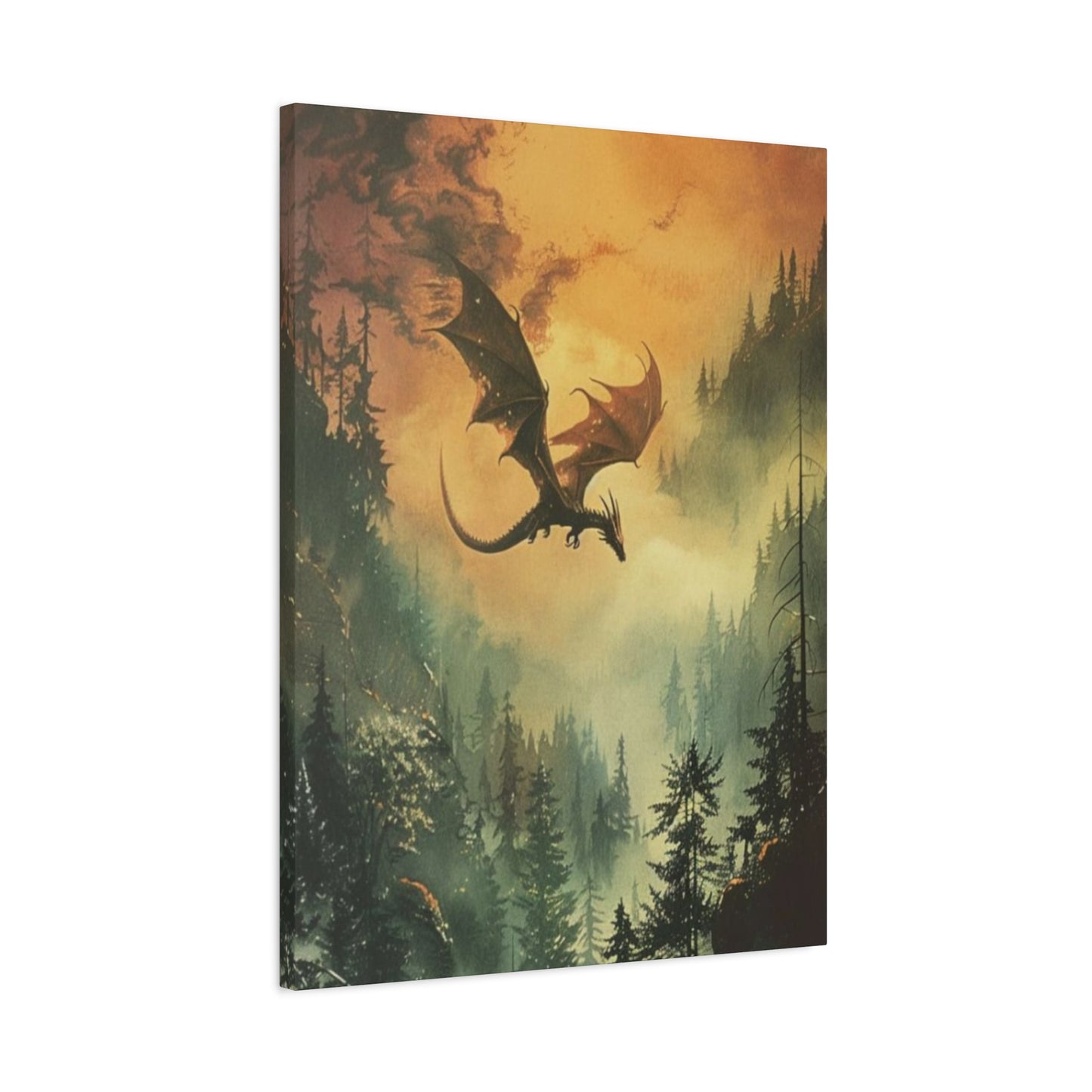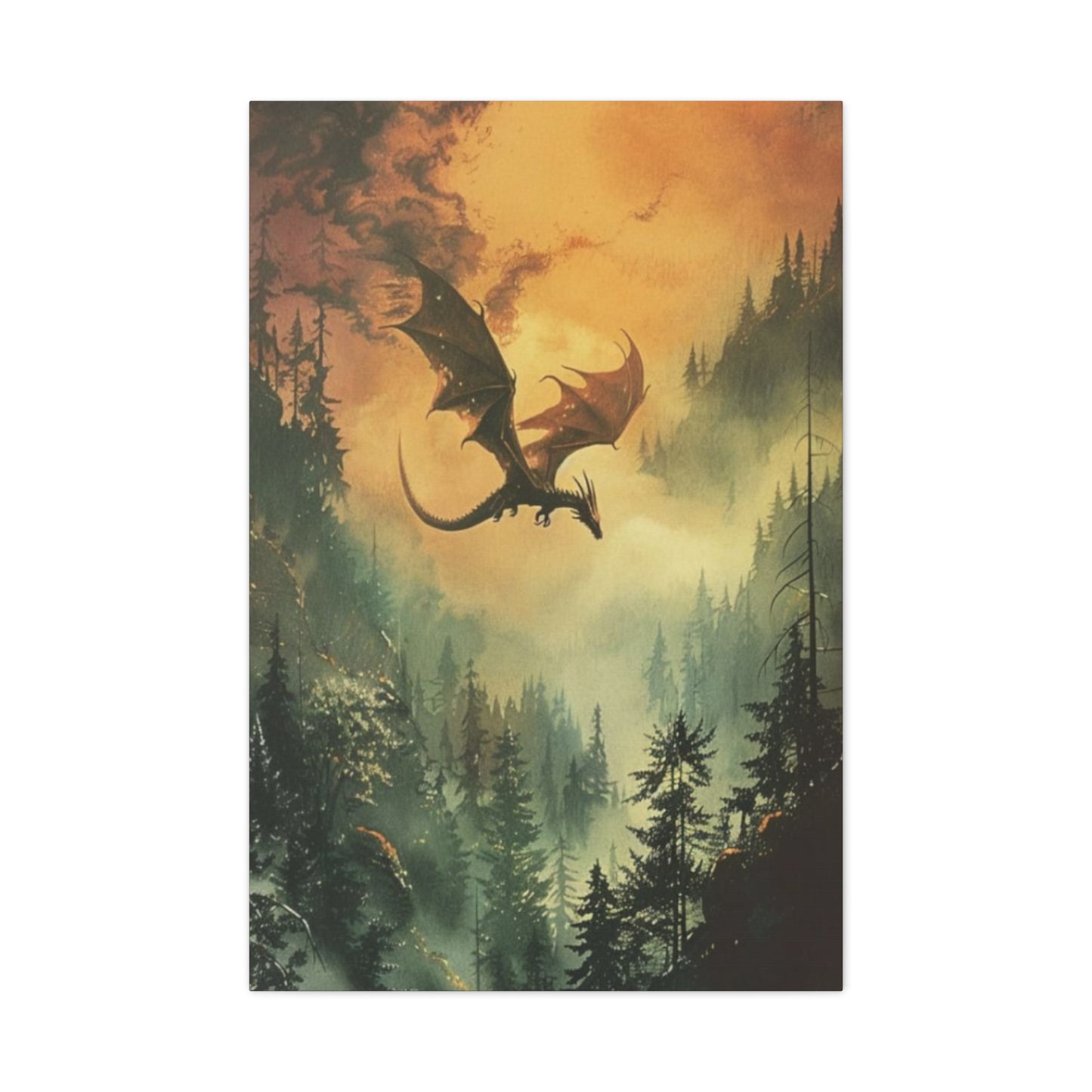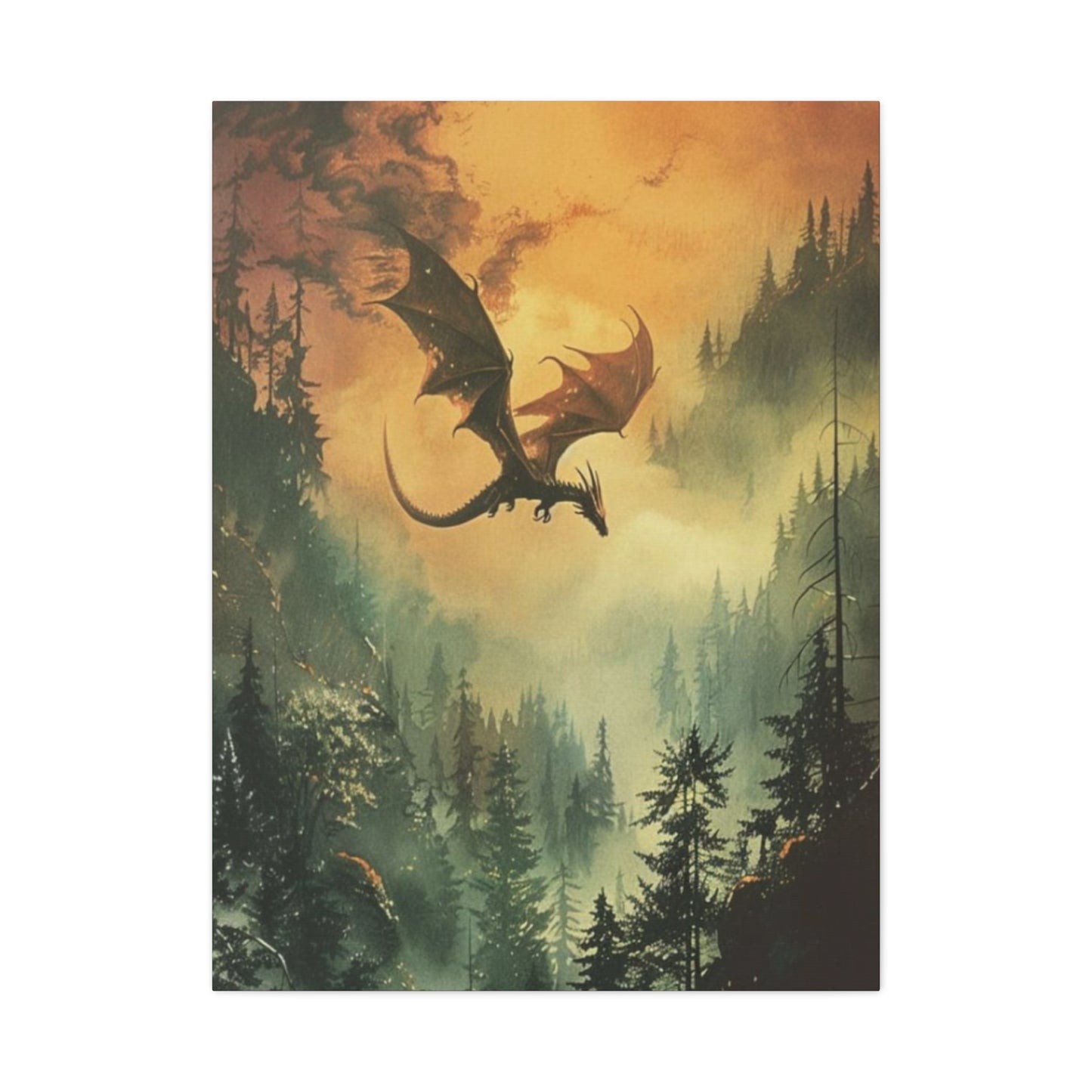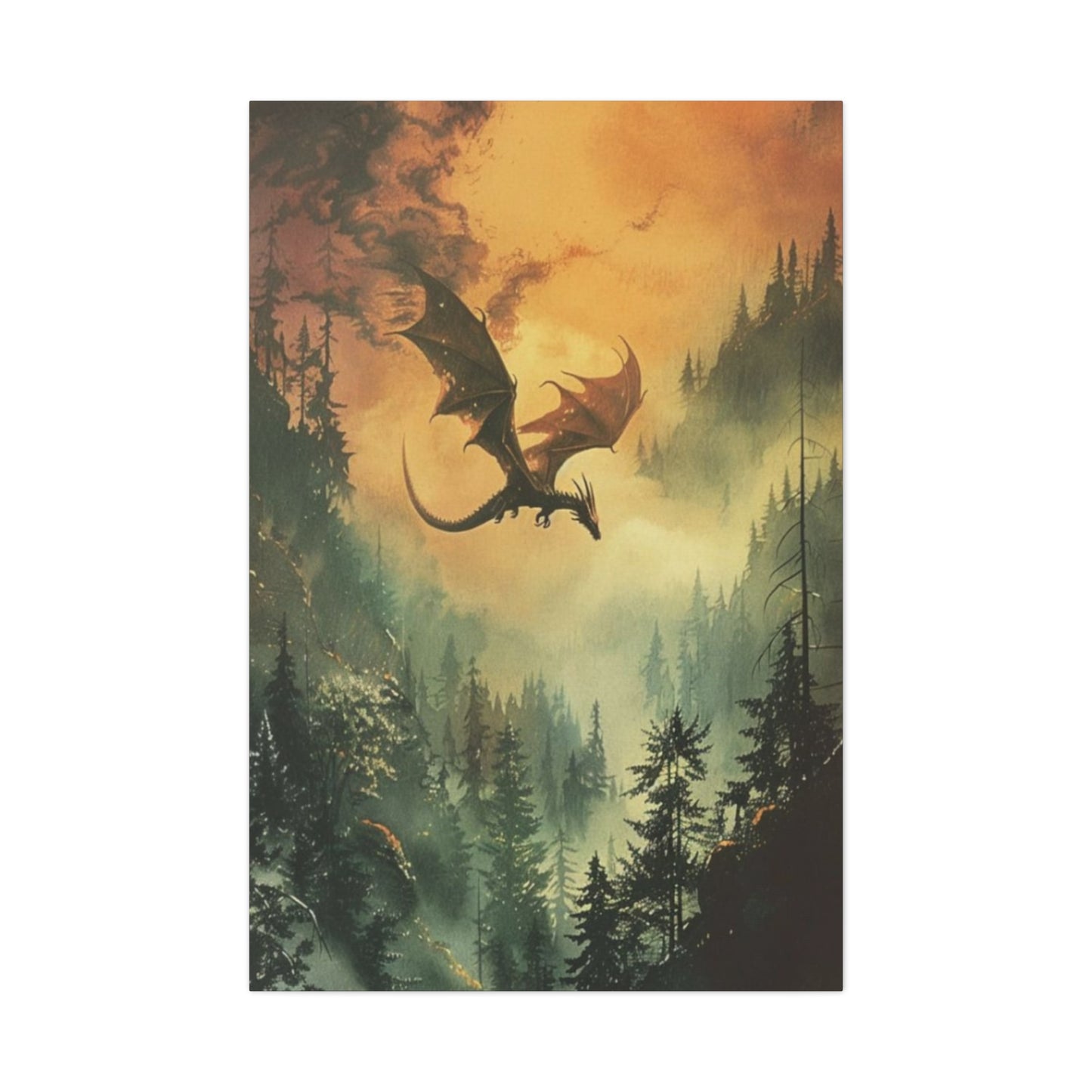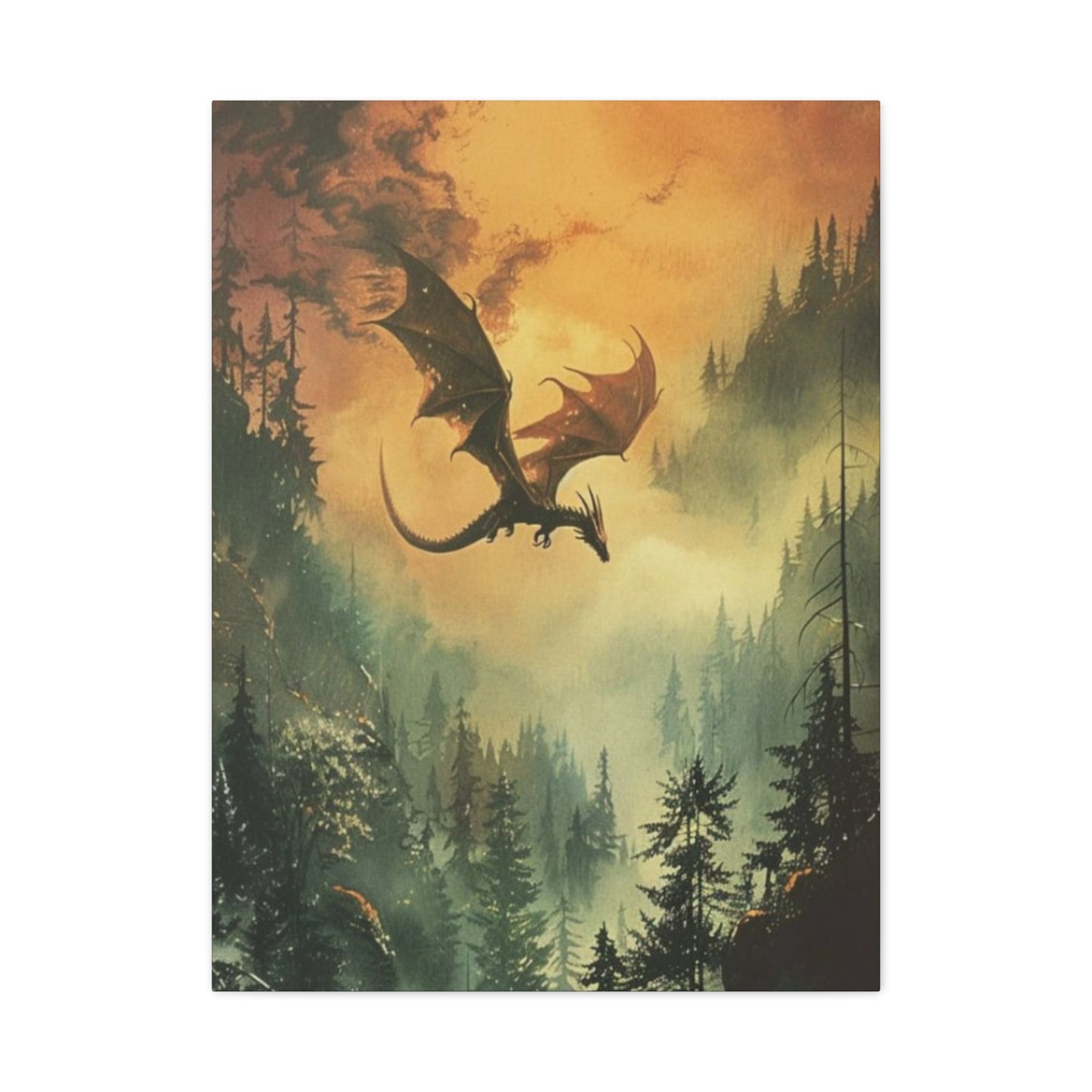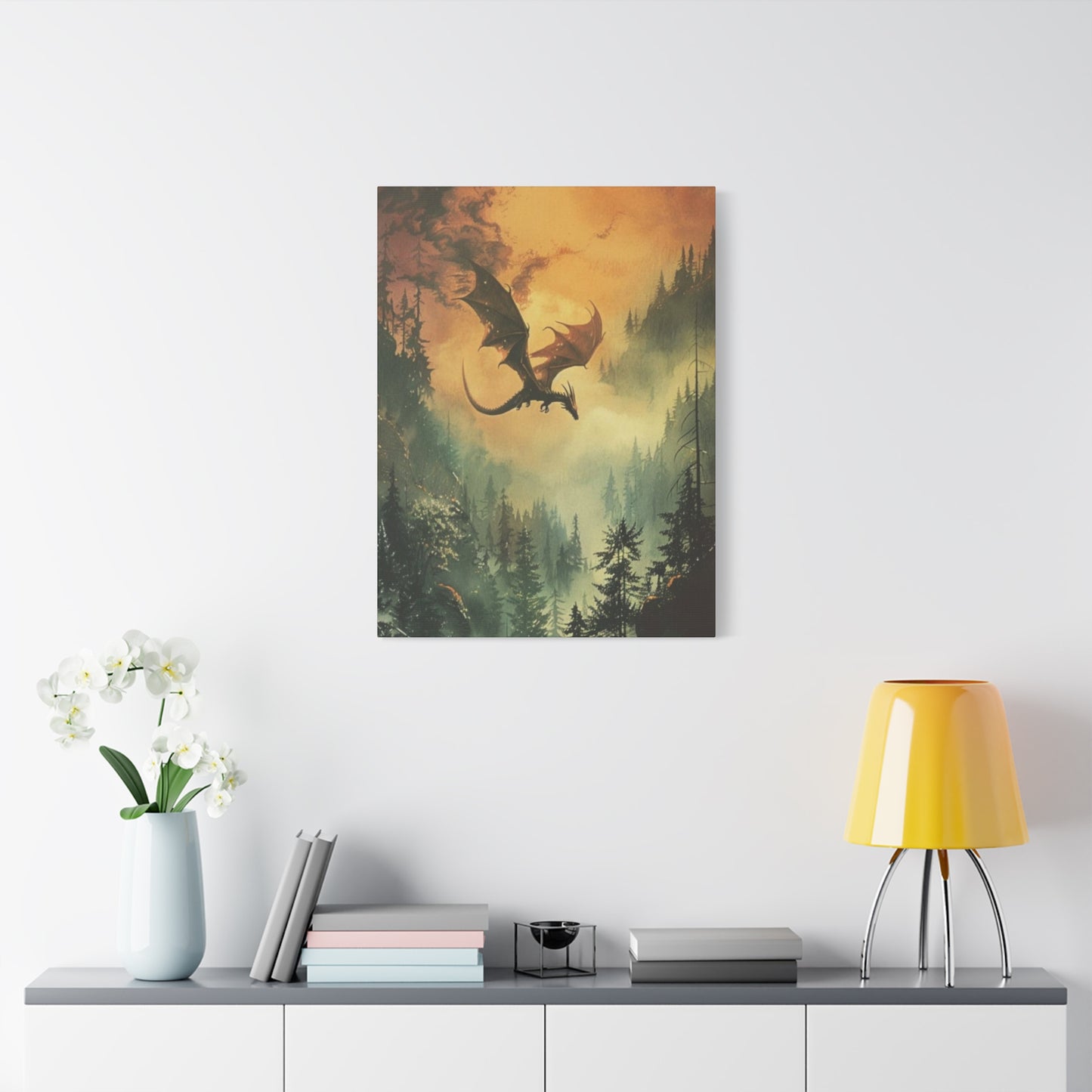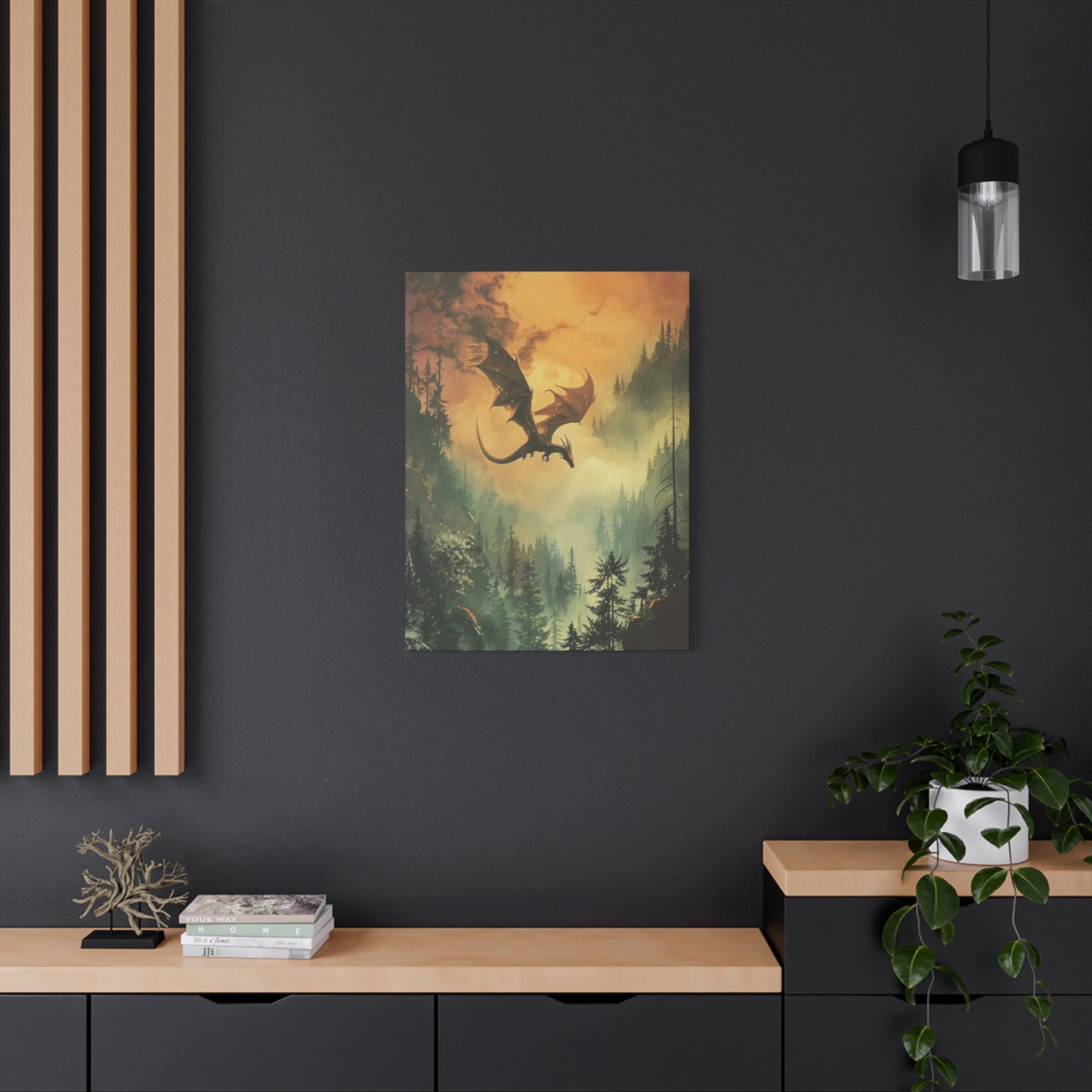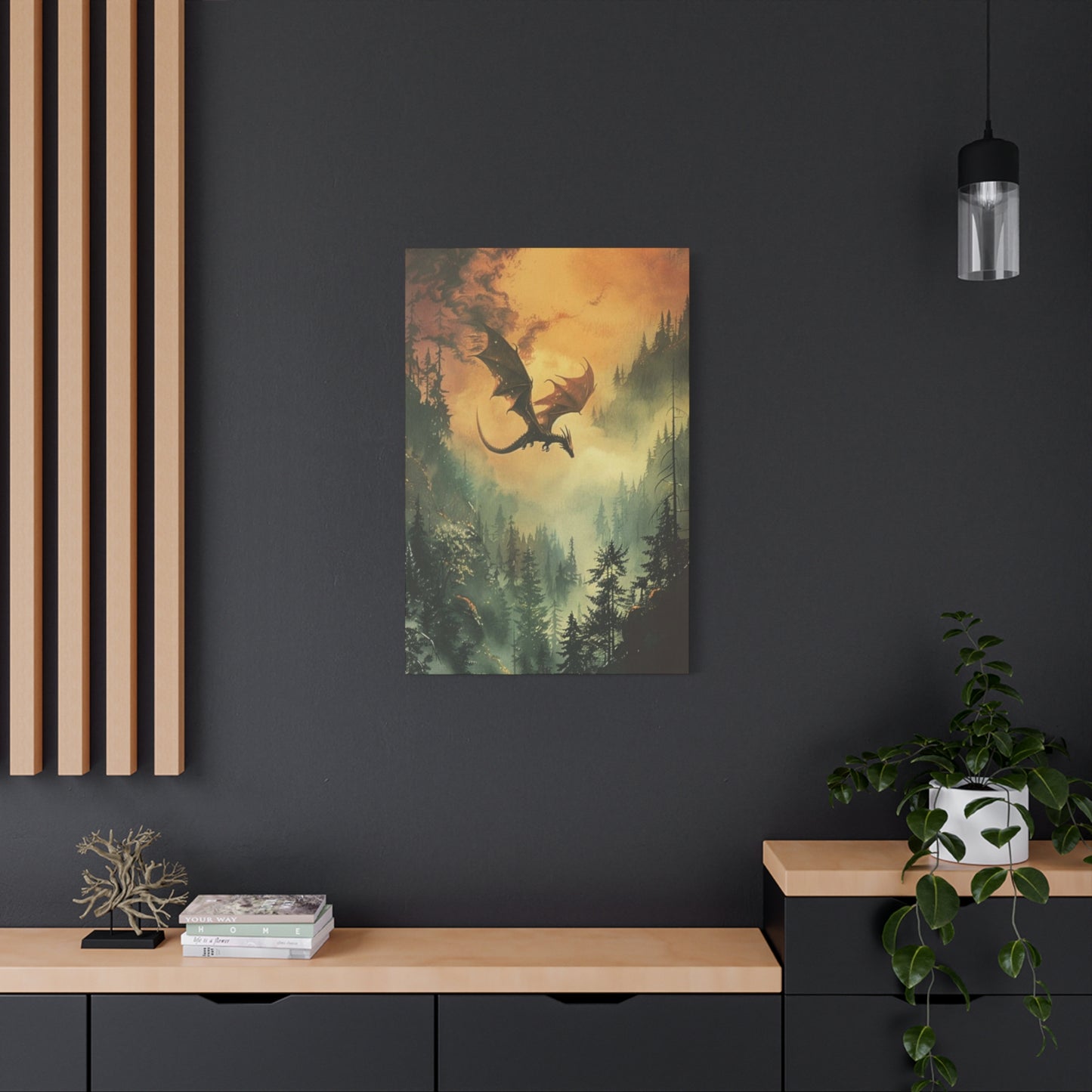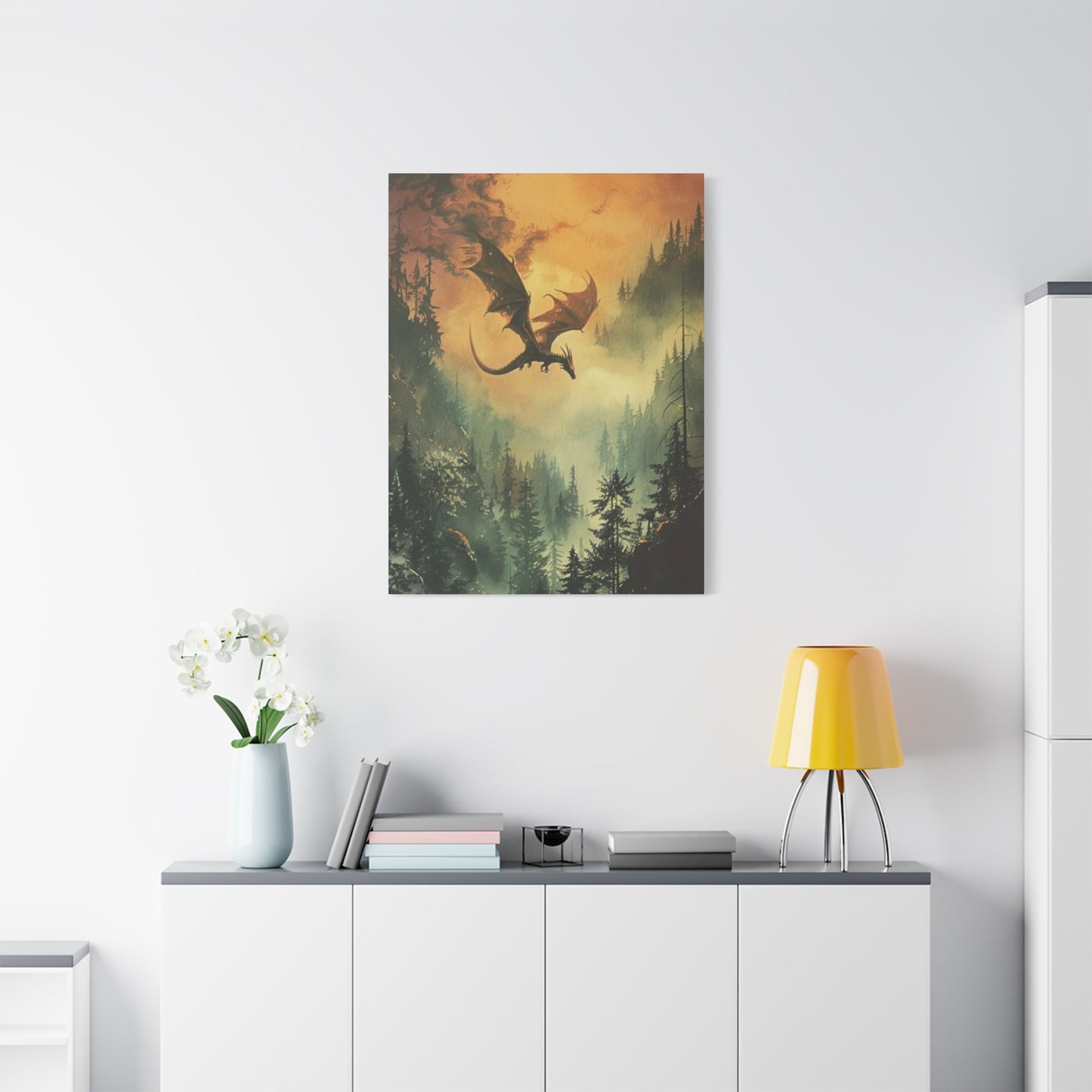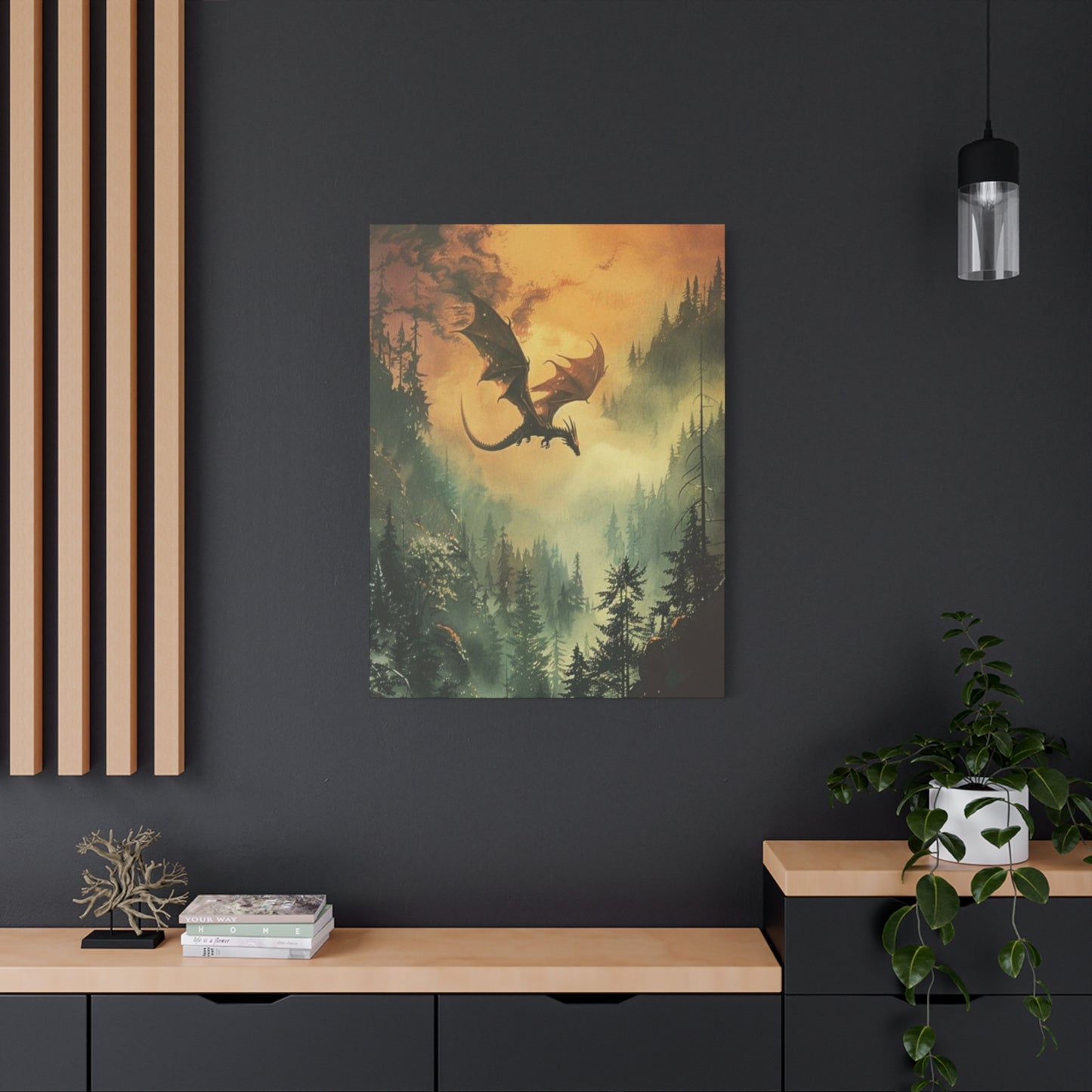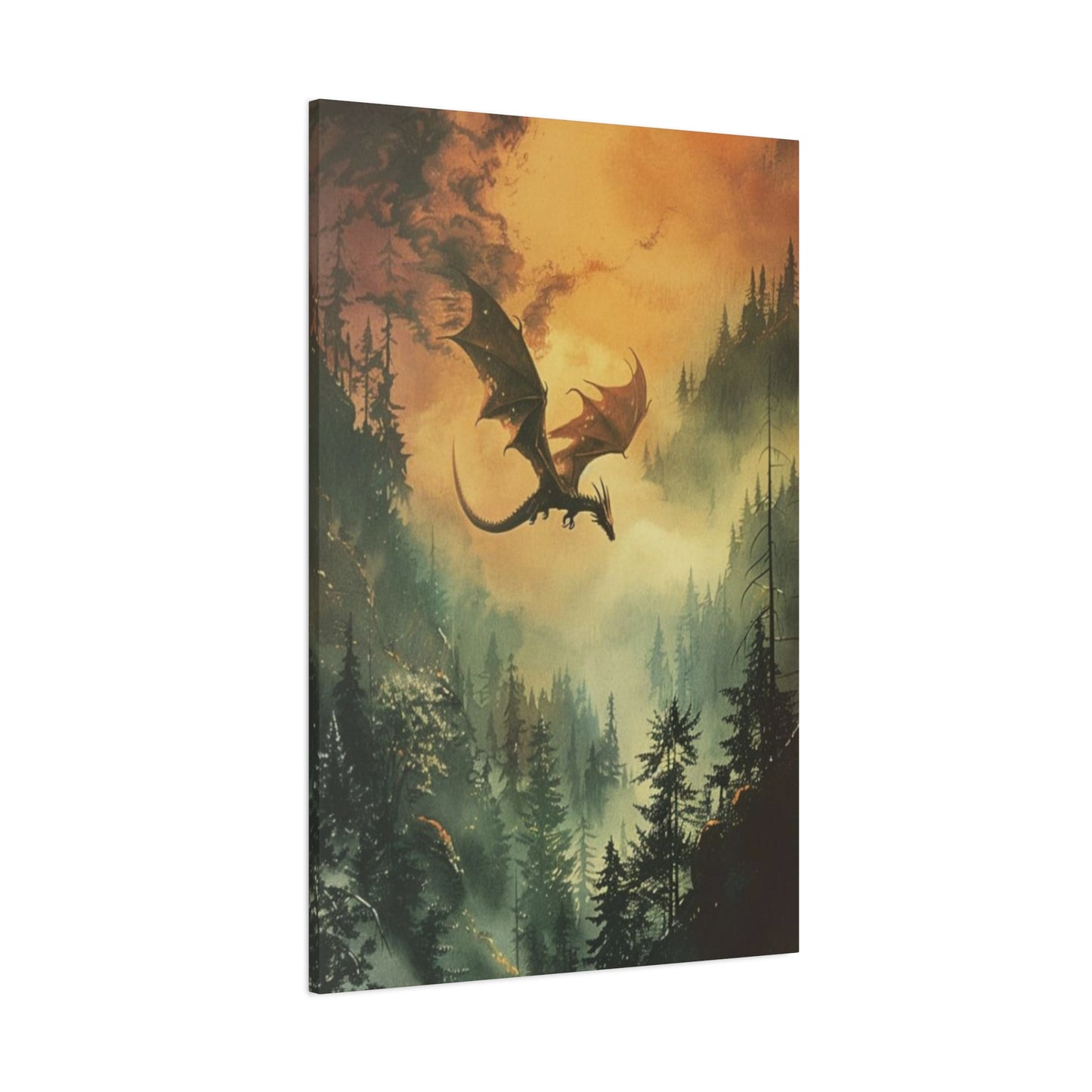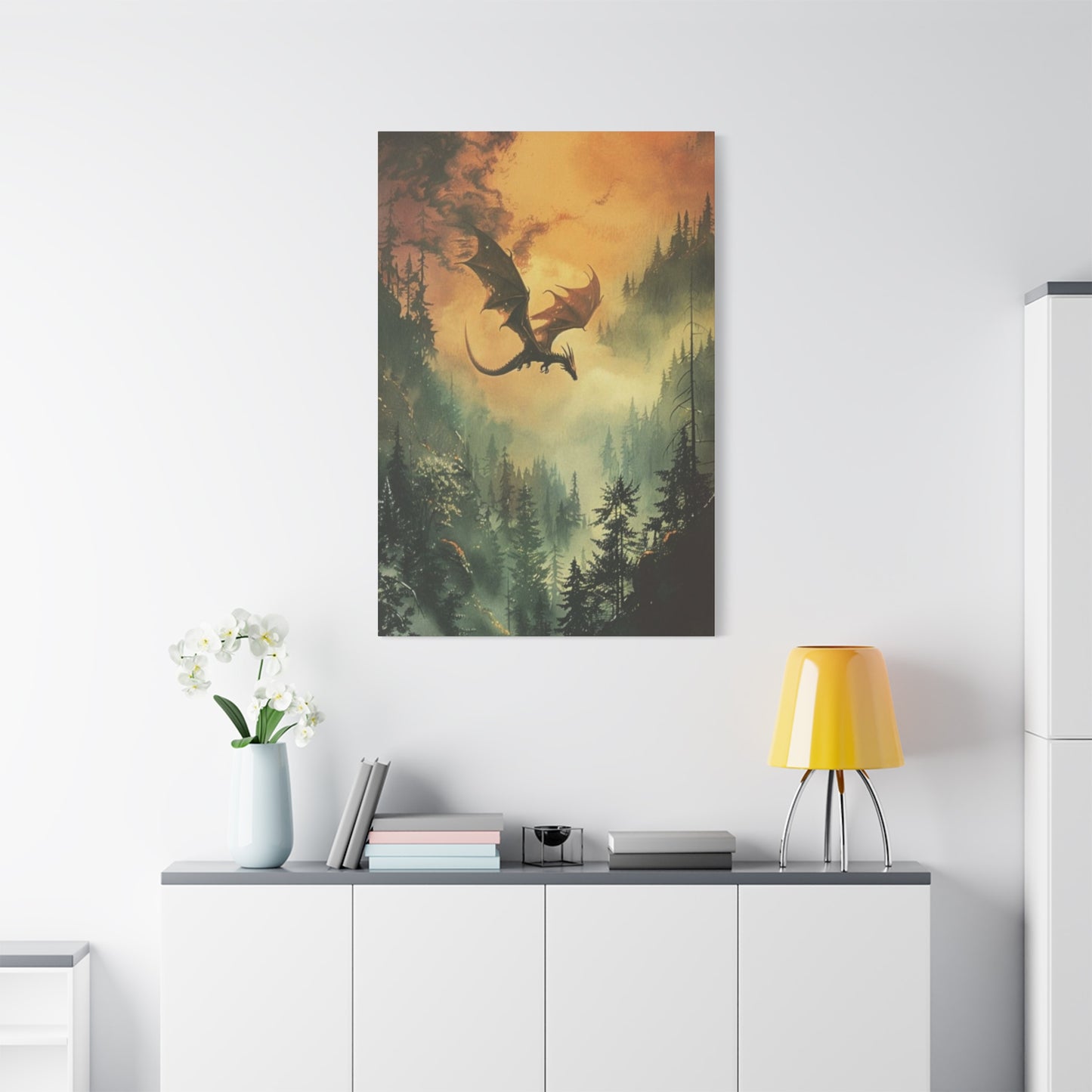Majestic Dragon Forest Wall Art: Bringing Mythical Creatures to Life in Your Home
The captivating imagery of dragons soaring through enchanted forests has captured human imagination for centuries. These magnificent creatures, with their powerful wings spread against backdrops of ancient trees and mystical woodlands, create some of the most compelling visual narratives in contemporary home décor. When dragons take flight through forest scenes, they embody the perfect marriage between the wild, untamed nature of woodland environments and the supernatural power of mythical beasts.
Dragon flight compositions in forest settings offer viewers a glimpse into otherworldly realms where magic still exists. The dynamic movement of a dragon's wings cutting through misty forest air creates natural focal points that draw the eye upward and outward, expanding the perceived boundaries of any room. These artworks typically feature dragons in various stages of flight, from graceful gliding motions to powerful ascending maneuvers that seem to defy the physical limitations of the forest canopy.
The positioning of dragons within forest scenes requires careful consideration of scale and proportion. Artists often employ techniques that make the dragon appear both integrated with the natural environment while simultaneously transcending it. This balance creates visual tension that keeps viewers engaged, as their eyes move between the familiar elements of trees, foliage, and natural lighting, and the fantastical presence of the dragon itself.
Forest environments provide rich textural contrasts that complement the sleek, powerful forms of dragons. The rough bark of ancient oaks and the delicate patterns of fern fronds create compelling juxtapositions against the smooth scales and membranous wings of these mythical creatures. This interplay between natural textures and fantastical forms adds depth and visual interest to any living room or personal sanctuary.
The atmospheric quality of forest scenes enhances the mystical presence of dragons in flight. Morning mist filtering through tree branches, dappled sunlight creating pools of golden light, and the deep shadows of woodland interiors all contribute to the sense that these creatures could actually exist in such magical environments. These atmospheric elements help blur the line between reality and fantasy, making the artwork more immersive and emotionally resonant.
Contemporary artists working in this genre often incorporate environmental storytelling elements that suggest narratives beyond the immediate visual impact. Ancient ruins hidden among the trees, mysterious pathways winding through the undergrowth, or glimpses of distant mountains all contribute to the sense that the dragon's flight is part of a larger, ongoing adventure that extends beyond the boundaries of the artwork itself.
The temporal quality of dragon flight scenes adds another layer of visual appeal. Whether capturing the split-second moment of a dragon's powerful wingbeat or the graceful arc of a creature banking through the forest canopy, these images freeze dynamic moments that suggest both the action that came before and the movement that will follow. This temporal suspension creates a sense of anticipation and energy that enlivens any room.
Choosing Dragon and Forest Wall Art
Selecting the perfect dragon and forest wall art requires careful consideration of multiple factors that will influence both the visual impact and the long-term satisfaction with your chosen piece. The size of your available wall area serves as the primary constraint, but within those boundaries, numerous artistic and stylistic choices await exploration. Understanding how different dragon and forest compositions will interact with your existing décor, lighting conditions, and personal aesthetic preferences ensures that your selection will enhance rather than compete with your overall design scheme.
The artistic style of dragon and forest wall art varies dramatically across different approaches and techniques. Traditional oil paintings often feature richly detailed forest environments with meticulously rendered dragon anatomy, creating works that reward close examination while maintaining visual impact from across the room. Watercolor interpretations tend toward more ethereal, dreamlike qualities that can soften the potentially overwhelming presence of large mythical creatures, making them suitable for more intimate or delicate decorating schemes.
Digital art and mixed media approaches offer contemporary alternatives that can incorporate photorealistic forest backgrounds with stylized or fantastical dragon representations. These modern techniques often allow for more vibrant color palettes and experimental compositional arrangements that might not be achievable through traditional painting methods. The choice between traditional and contemporary approaches often reflects personal preference as well as the overall aesthetic direction of your home's decoration.
Subject matter variations within the dragon and forest theme provide numerous options for personal expression and thematic consistency. Some artworks focus primarily on the natural beauty of forest environments, with dragons serving as mysterious inhabitants rather than dominant subjects. Others place the mythical creature at the center of the composition, using forest elements as supporting environmental context. The balance between natural and fantastical elements significantly impacts the overall mood and visual weight of the piece.
Color harmony between your chosen artwork and existing room elements requires careful evaluation of both dominant and accent colors within the composition. Forest scenes naturally incorporate earth tones, greens, and browns, which tend to work well with most decorating schemes, but the treatment of dragon elements can introduce unexpected color notes that either enhance or clash with your established palette. Consider how metallic highlights, vibrant scale colorations, or magical lighting effects within the artwork will interact with your furniture, textiles, and other decorative elements.
The emotional tone conveyed by different dragon and forest combinations varies significantly based on artistic interpretation and compositional choices. Some works emphasize the peaceful coexistence between dragons and natural environments, creating serene, contemplative atmospheres suitable for bedrooms or meditation areas. Others highlight the dramatic tension between powerful creatures and wild landscapes, generating energy and excitement more appropriate for living areas or entertainment rooms.
Technical considerations such as print quality, color accuracy, and longevity become particularly important when investing in larger or more expensive pieces. Digital reproductions of original artworks can vary dramatically in quality, with factors such as paper type, printing methods, and color calibration all affecting the final visual impact. Original paintings and limited edition prints typically offer superior visual depth and texture but command correspondingly higher prices.
Frame selection and matting options provide additional opportunities to customize your dragon and forest wall art to match your specific decorating goals. Traditional wooden frames can emphasize the natural forest elements within the composition, while sleek modern frames might highlight the fantastical aspects of the dragon imagery. The width and color of matting can significantly alter the visual weight and presence of the artwork within your room.
Colors in Dragon and Forest Art
The color palette employed in dragon and forest art plays a crucial role in establishing mood, creating visual harmony, and determining the emotional impact of these powerful compositions. Forest environments naturally provide a foundation of earth tones, with rich browns, deep greens, and warm amber highlights creating the base upon which dragon imagery can be layered. However, the treatment of these natural colors, combined with the artistic interpretation of dragon characteristics, can result in dramatically different visual experiences.
Traditional forest color schemes emphasize the organic beauty of natural woodland environments. Deep forest greens dominate the canopy areas, while undergrowth typically incorporates various shades of brown, from rich chocolate tones in tree bark to warm sienna notes in fallen leaves and forest floor elements. These earth-based palettes create calming, grounding effects that work particularly well in bedrooms, studies, or other areas where tranquility and contemplation are desired.
The introduction of dragon elements into forest color schemes provides opportunities for dramatic contrast and visual excitement. Dragons themselves can be rendered in virtually any color combination, from traditional representations featuring metallic scales in gold, bronze, or silver, to more fantastical interpretations incorporating jewel tones, iridescent effects, or supernatural colorations that seem to glow with inner light. The choice of dragon coloration significantly impacts the overall balance and energy of the composition.
Atmospheric effects within dragon and forest art often rely on sophisticated color temperature variations to create depth and believability. Cool blue-gray tones in distant forest areas suggest atmospheric perspective, while warmer golden or orange highlights in foreground elements bring those areas forward visually. The interplay between warm and cool colors helps establish the three-dimensional quality that makes these fantastical scenes feel more realistic and immersive.
Lighting effects represent one of the most challenging and rewarding aspects of color work in dragon and forest compositions. Natural forest lighting, filtered through dense canopies and creating dappled patterns on the forest floor, requires subtle gradations and careful attention to color temperature variations. When combined with supernatural lighting effects associated with dragon presence, such as flame illumination, magical auras, or the glow of dragon scales, artists must balance realistic natural lighting with fantastical elements that enhance the magical quality of the scene.
Seasonal variations in forest colors provide additional creative opportunities for artists working in this genre. Spring forest scenes might emphasize fresh green tones and delicate flower colors, creating lighter, more optimistic moods that work well with dragons depicted in peaceful or protective roles. Autumn compositions can incorporate rich oranges, deep reds, and golden yellows that complement metallic dragon colorations and create warm, inviting atmospheres perfect for gathering areas.
The psychological impact of color choices in dragon and forest art extends beyond simple aesthetic preferences. Colors influence mood, energy levels, and emotional responses in ways that can significantly affect how comfortable and happy people feel in decorated environments. Cooler color palettes tend to create calming, restful atmospheres, while warmer colors generate energy and excitement. The balance between these qualities allows for fine-tuning the emotional impact of your chosen artwork.
Metallic elements in dragon and forest art require special consideration in terms of both artistic technique and room lighting conditions. Metallic highlights on dragon scales, armor, or magical elements can create stunning visual effects under proper lighting but may appear dull or lifeless in poorly lit areas. The reflective qualities of metallic elements also mean that their appearance will change throughout the day as natural lighting conditions shift, adding dynamic visual interest to the artwork.
Color saturation levels significantly affect the overall impact and versatility of dragon and forest art. Highly saturated colors create bold, dramatic effects that can serve as focal points in room design but may become overwhelming in smaller areas or compete with other decorative elements. More muted, desaturated color palettes tend to integrate more easily with existing décor while still providing the visual interest and thematic content that makes dragon and forest art appealing.
Symbolism of Dragons in Nature
The symbolic relationship between dragons and natural environments carries profound meaning that extends far beyond simple decorative appeal. Throughout human history, dragons have served as powerful symbols representing the untamed forces of nature, the wisdom of ancient knowledge, and the bridge between earthly and spiritual realms. When depicted in forest settings, these meanings become amplified and enriched by the additional symbolism inherent in woodland environments.
Dragons traditionally represent power, wisdom, and transformation in numerous cultural contexts. In Western traditions, dragons often symbolize the challenges that must be overcome to achieve personal growth and enlightenment. When placed in forest environments, this symbolism takes on additional layers of meaning related to the journey through unknown territories, the facing of one's fears in dark places, and the ultimate emergence into light and understanding. The forest becomes both the testing ground and the source of the wisdom that the dragon guards or represents.
Eastern cultural interpretations of dragons emphasize their role as benevolent forces of nature, often associated with water, weather, and agricultural fertility. In these contexts, dragons in forest settings represent the harmonious relationship between supernatural wisdom and natural abundance. The forest provides the perfect environment for displaying this harmony, with the dragon serving as both protector and participant in the natural cycle of growth, death, and renewal that characterizes woodland ecosystems.
The symbolic significance of forests themselves adds depth to dragon imagery. Forests represent the unconscious mind, the unknown, and the journey into self-discovery. They are places of transformation where heroes and heroines in countless stories face trials, gain wisdom, and emerge changed. Dragons in forest settings embody the transformative power of these journeys, serving as both guides and challenges that lead to personal growth and expanded consciousness.
The cyclical nature of forest life provides rich symbolic content for dragon art. Trees grow, age, die, and decay, providing nourishment for new growth in endless cycles that mirror the larger patterns of existence. Dragons, often depicted as immortal or extremely long-lived creatures, represent the continuity that transcends individual cycles while participating in the larger rhythms of natural existence. This symbolism resonates particularly strongly with viewers seeking to connect with themes of permanence, wisdom, and spiritual continuity.
Environmental symbolism in dragon and forest art often addresses contemporary concerns about the relationship between human civilization and natural world preservation. Dragons can represent the wild, untamed aspects of nature that resist human control and domination. In this interpretation, forest scenes serve as sanctuaries where ancient wisdom and natural power persist despite encroaching human influence. This symbolism appeals to viewers who seek to maintain connection with natural environments and values in increasingly urbanized world.
The guardian archetype frequently appears in dragon and forest symbolism, with dragons serving as protectors of sacred groves, hidden knowledge, or natural treasures. This protective symbolism can extend to the home environment, where dragon and forest art serves as a symbolic guardian for the family and the domestic sanctuary. The presence of dragon imagery can create a sense of protection and security while the forest elements provide grounding and connection to natural rhythms.
Transformation and rebirth themes are central to both dragon and forest symbolism. Dragons are creatures of change, often associated with fire, earth, air, and water elements that facilitate transformation. Forests are environments where death and rebirth occur constantly, with fallen trees providing nourishment for new growth and seasonal changes marking the passage of time. Together, these symbols create powerful representations of personal growth, life transitions, and spiritual evolution.
The balance between civilization and wildness finds expression in dragon and forest symbolism. Dragons represent forces that cannot be fully tamed or controlled, while forests embody the wild aspects of nature that exist beyond human manipulation. This symbolism appeals to viewers who seek to maintain balance between their civilized, domestic lives and their need for connection with wilder, more primal aspects of existence.
Framing Dragon Over Forest Prints
The selection and application of appropriate framing for dragon over forest prints requires careful consideration of both aesthetic and practical factors that will influence the long-term visual impact and preservation of your artwork. The frame serves as the transition between the fantastical world depicted in the print and the real environment of your home, making its selection crucial to the successful integration of dragon and forest themes into your living environment.
Traditional wooden frames offer natural harmony with forest themes, creating visual continuity between the natural elements within the artwork and the organic materials of the frame itself. Oak, walnut, and other hardwood frames can echo the tree species depicted in the forest scenes, strengthening the thematic connection while providing the substantial presence necessary to support larger prints. The grain patterns and natural variations in wood frames add textural interest that complements the organic elements within dragon and forest compositions.
The width and profile of wooden frames significantly affect the visual weight and presence of dragon prints. Narrow frames allow the artwork to dominate the visual field, creating more immersive viewing experiences that can make the fantastical elements feel more immediate and real. Wider frames create stronger boundaries between the artwork and the surrounding room, which can help contain the dramatic energy of dragon imagery while providing elegant presentation that works well in more formal decorating schemes.
Metal frames provide contemporary alternatives that can emphasize the fantastical aspects of dragon imagery while maintaining clean, unobtrusive presentation. Brushed aluminum, bronze, or copper frames can echo the metallic qualities often present in dragon scales or magical elements within the artwork. The reflective properties of metal frames can also interact with room lighting to create subtle variations in appearance throughout the day, adding dynamic qualities that enhance the magical atmosphere of dragon and forest themes.
Ornate or decorative frames can enhance the mythical and fantastical qualities of dragon art but require careful selection to avoid overwhelming the artwork itself. Gothic-inspired frames with carved details or metalwork elements can reinforce fantasy themes, while frames with natural motifs such as carved leaves, branches, or wildlife can strengthen the connection to forest environments. The key is achieving balance between frame decoration and artwork content to ensure that both elements support rather than compete with each other.
Matting options provide additional opportunities to customize the presentation of dragon and forest prints while protecting the artwork and creating visual breathing room around the image. Traditional white or cream matting creates clean, gallery-style presentation that allows the artwork to speak for itself, while colored matting can be selected to emphasize particular color notes within the composition or to create harmony with room décor elements.
The width of matting significantly affects the visual impact and perceived size of dragon prints. Narrow matting maintains intimate connection between viewer and artwork, while wider matting creates more formal, gallery-like presentation that can elevate the perceived importance and artistic value of the piece. Multiple mat layers, using different colors or textures, can create sophisticated presentations that add depth and visual interest without detracting from the artwork itself.
Conservation considerations become particularly important when framing valuable or irreplaceable dragon and forest prints. Acid-free matting materials prevent chemical degradation over time, while UV-filtering glazing protects colors from fading due to sunlight exposure. Museum-quality framing materials and techniques ensure that prints will maintain their visual impact and value for decades, making them worthwhile investments for serious collectors or those planning to keep their artwork for extended periods.
Glass versus acrylic glazing presents trade-offs between optical clarity, weight, and safety considerations. Traditional glass provides superior optical clarity and scratch resistance but adds significant weight to larger frames and creates safety hazards if broken. Acrylic alternatives are lighter and safer but can be more prone to scratching and may create static electricity that attracts dust. The choice often depends on the size of the print, the location where it will hang, and personal preferences regarding maintenance requirements.
Frame color selection requires consideration of both the artwork's color palette and the room's decorating scheme. Neutral frame colors such as black, white, or natural wood tones tend to work well with most dragon and forest compositions while providing flexibility for future decorating changes. Bold or colorful frames can create striking effects but may limit the versatility of the artwork if room décor changes over time.
Creating Fantasy with Dragon Art
The creation of compelling fantasy atmospheres through dragon art involves masterful manipulation of visual elements that transport viewers from ordinary reality into realms where magic and wonder are not only possible but inevitable. Successful fantasy dragon art achieves this transformation through careful attention to composition, lighting, detail work, and the subtle cues that signal to viewers that they are encountering something beyond the mundane world of everyday experience.
Atmospheric perspective plays a crucial role in establishing the fantastical quality of dragon art. Artists employ techniques that suggest vast distances, mysterious depths, and otherworldly environments that extend far beyond the boundaries of the artwork itself. Layers of atmospheric haze, carefully graduated color temperatures, and strategic use of detail versus suggestion create the impression of expansive fantasy realms that invite exploration and wonder.
The scale relationships between dragons and environmental elements significantly impact the sense of fantasy and wonder. Dragons depicted as massive creatures that dwarf ancient forest trees create feelings of awe and power, while smaller dragons integrated more intimately with natural environments suggest magical creatures that exist alongside familiar natural elements. The choice of scale affects not only visual impact but also the type of fantasy narrative that viewers construct around the artwork.
Lighting effects serve as one of the most powerful tools for creating fantasy atmospheres in dragon art. Supernatural lighting sources, such as magical flames, glowing dragon scales, or mysterious forest illumination, immediately signal to viewers that they are encountering a world where different rules apply. The interplay between natural and supernatural lighting creates visual complexity that rewards careful examination while maintaining overall coherence and believability.
Environmental details contribute significantly to the fantasy atmosphere of dragon art. Ancient ruins hidden among forest growth suggest civilizations lost to time, while mysterious pathways disappearing into woodland depths invite viewers to imagine the adventures that might await beyond the visible boundaries. These narrative elements transform static images into windows into ongoing fantasy worlds that continue to exist beyond the moment captured in the artwork.
Color palette choices dramatically affect the fantasy atmosphere of dragon compositions. While naturalistic colors create believability and grounding, strategic use of otherworldly colors such as magical purples, ethereal blues, or supernatural greens can transform ordinary forest scenes into fantastical environments. The balance between familiar and otherworldly colors allows artists to create fantasy atmospheres that remain accessible and appealing to viewers.
Texture work in fantasy dragon art requires careful balance between realistic detail and imaginative interpretation. Dragon scales, forest bark, magical effects, and atmospheric elements must be rendered with enough detail to seem believable while maintaining the sense of wonder that distinguishes fantasy from mere natural history illustration. The tactile quality suggested by texture work helps viewers feel immersed in the fantasy environment.
Compositional techniques that draw viewers into fantasy dragon art often employ multiple focal points and visual pathways that encourage exploration of the entire image. Rather than single-point compositions that direct attention to one primary element, fantasy art benefits from layered compositions that reward continued viewing with new discoveries and details that weren't immediately apparent.
The integration of realistic and fantastical elements requires sophisticated artistic judgment to maintain believability while creating wonder. Dragons must seem to belong in their forest environments while simultaneously transcending the limitations of ordinary natural law. This integration often relies on subtle details such as the way light falls on dragon scales, how creature weight affects interaction with forest floor elements, or the response of natural elements to supernatural presence.
Mythological references and symbolic elements can deepen the fantasy atmosphere by connecting dragon art to broader cultural traditions of magic and wonder. Ancient symbols, runic inscriptions, mystical artifacts, or references to legendary creatures and locations can transform individual artworks into windows into rich fantasy mythologies that extend far beyond the immediate visual content.
Realistic vs Fantasy Dragon Paintings
The artistic choice between realistic and fantasy approaches to dragon paintings creates fundamentally different viewing experiences that appeal to different aesthetic preferences and serve different decorative functions. Realistic dragon paintings attempt to depict these mythical creatures as though they were actual biological entities subject to natural laws, while fantasy approaches embrace the supernatural and impossible aspects that make dragons compelling mythological subjects.
Realistic dragon paintings employ scientific accuracy in anatomy, movement, and environmental interaction to create believable depictions of creatures that might actually exist. Artists working in this style study bird and bat flight mechanics, reptilian anatomy, and predator behavior to inform their dragon depictions. The resulting artworks possess a documentary quality that can make dragons seem like undiscovered rather than imaginary creatures, appealing to viewers who prefer their fantasy grounded in biological plausibility.
The environmental integration in realistic dragon paintings requires careful attention to physics, scale, and natural behavior patterns. Dragons must cast appropriate shadows, disturb vegetation in believable ways, and interact with their forest environments according to their depicted size and weight. This attention to natural law creates internal consistency that allows viewers to suspend disbelief more easily, making the fantastical seem possible rather than impossible.
Fantasy dragon paintings embrace the impossible and supernatural aspects that make dragons compelling mythological figures. These works might feature dragons that glow with inner light, possess impossible anatomical features, or demonstrate magical abilities that transcend natural law. The appeal lies not in biological plausibility but in the wonder and excitement generated by encounters with the truly supernatural and impossible.
Color treatment differs significantly between realistic and fantasy approaches to dragon painting. Realistic works tend toward natural color palettes that reflect actual reptilian, avian, or mammalian colorations found in nature. Fantasy approaches can employ any color combination imaginable, from iridescent scales that shift color in impossible ways to dragons whose very presence seems to alter the colors of their surrounding environment.
Lighting techniques serve different purposes in realistic versus fantasy dragon paintings. Realistic works use lighting to enhance the three-dimensional quality and natural believability of dragon anatomy and environmental interaction. Fantasy paintings can employ impossible lighting effects, supernatural illumination sources, or magical interactions between dragon presence and environmental lighting that create otherworldly atmospheres.
The level of anatomical detail appropriate for realistic versus fantasy dragon paintings varies significantly based on artistic goals. Realistic works benefit from meticulous attention to muscle structure, scale patterns, wing membrane details, and other anatomical elements that contribute to biological believability. Fantasy works might emphasize magical or supernatural qualities over anatomical accuracy, using stylization and artistic license to create more emotionally impactful rather than scientifically plausible depictions.
Environmental treatment in realistic dragon paintings requires careful attention to ecological accuracy and natural habitat requirements. Forest environments must seem capable of supporting the depicted dragon populations, with appropriate food sources, nesting sites, and territorial considerations reflected in the composition. Fantasy approaches can ignore these practical limitations, creating impossible environments that exist purely to support the magical atmosphere of the piece.
The emotional impact of realistic versus fantasy dragon paintings appeals to different viewer preferences and psychological needs. Realistic dragons can satisfy intellectual curiosity and appeal to viewers who appreciate technical skill and biological accuracy. Fantasy dragons appeal more to emotional and imaginative responses, offering escape from rational limitations and invitation into purely magical realms.
Market considerations often influence the choice between realistic and fantasy approaches to dragon painting. Realistic dragon art appeals to collectors interested in natural history illustration, fantasy art with scientific grounding, and works that demonstrate technical artistic skill. Fantasy dragon art attracts collectors drawn to pure imagination, emotional impact, and artwork that serves as windows into magical realms unconstrained by natural law.
The versatility of realistic versus fantasy dragon paintings in home décor applications reflects their different aesthetic qualities and emotional impacts. Realistic dragon art tends to integrate more easily with natural décor themes, earth-tone color schemes, and environments where biological accuracy is appreciated. Fantasy dragon art works better in settings that embrace bold colors, dramatic visual impact, and décor themes that celebrate imagination over natural accuracy.
DIY Dragon and Forest Wall Art
Creating your own dragon and forest wall art provides opportunities for personal expression, cost savings, and the satisfaction of producing unique decorative elements tailored specifically to your home environment and artistic preferences. DIY approaches range from simple projects suitable for beginners to complex undertakings that challenge experienced artists, with options available for virtually any skill level and time commitment.
Painting techniques for DIY dragon and forest art can accommodate various skill levels and artistic preferences. Acrylic paints offer beginner-friendly options with quick drying times, easy cleanup, and forgiving properties that allow for corrections and modifications during the painting process. Watercolors provide more challenging but potentially rewarding approaches that can create ethereal, dreamlike effects particularly suitable for fantasy dragon themes. Oil paints offer the greatest depth and richness but require more advanced skills and longer working times.
Canvas selection significantly affects both the painting process and the final appearance of DIY dragon and forest art. Stretched canvases provide traditional painting surfaces that work well with all paint types and offer professional appearance when completed. Canvas boards offer economical alternatives for practice pieces or smaller works, while canvas panels provide portable options for outdoor sketching or reference work. The texture and priming of the canvas affects paint application and final appearance, with smoother surfaces better for detailed work and rougher textures adding visual interest to broader treatments.
Digital art approaches to DIY dragon and forest creation open up possibilities for artists comfortable with technology and computer-based tools. Drawing tablets and stylus devices allow for precise control and natural drawing motions, while software applications provide tools for layering, color adjustment, and special effects that would be difficult or impossible to achieve with traditional media. Digital approaches also allow for easy experimentation, with unlimited opportunities to try different colors, compositions, and effects without wasting materials.
Mixed media techniques can create unique textures and visual effects that pure painting approaches cannot achieve. Collage elements such as textured papers, fabric pieces, or natural materials can add dimensional qualities to forest environments, while metallic leafing can create convincing dragon scale effects. The combination of different media requires planning and experimentation but can result in truly unique artworks that stand apart from conventional paintings.
Reference material collection forms the foundation of successful DIY dragon and forest art projects. Photographic references of forest environments, wildlife anatomy studies, and existing dragon art can provide inspiration and technical guidance for original creations. Building a comprehensive reference library helps ensure anatomical accuracy, realistic lighting effects, and convincing environmental details that make fantasy subjects more believable.
Composition planning prevents common mistakes and improves the likelihood of successful DIY dragon and forest art projects. Thumbnail sketches allow for experimentation with different arrangements of dragon and forest elements before committing to final compositions. Understanding principles such as rule of thirds, leading lines, and focal point placement helps create visually engaging arrangements that hold viewer attention and create satisfying viewing experiences.
Color mixing skills become particularly important when working with limited paint palettes to create the wide range of colors needed for convincing dragon and forest art. Understanding color theory, including complementary relationships, temperature variations, and mixing techniques, allows artists to achieve desired effects with minimal paint purchases. Practice exercises in color mixing can prevent frustration and wasted materials during actual project execution.
Detail work techniques separate amateur-appearing DIY projects from professional-quality results. Learning to suggest detail rather than laboriously painting every element saves time while creating more visually effective results. Understanding when to use sharp focus versus soft edges, how to create depth through atmospheric perspective, and techniques for suggesting texture without overworking surfaces all contribute to more successful finished pieces.
Finishing and presentation considerations ensure that completed DIY dragon and forest art projects achieve maximum visual impact and longevity. Proper varnishing or sealing protects painted surfaces from damage and fading, while appropriate mounting and framing present the work to best advantage. Understanding these final steps prevents disappointment when otherwise successful projects fail to achieve their full potential due to poor presentation or inadequate protection.
Combining Forest and Dragon Themes
The successful integration of forest and dragon themes requires sophisticated understanding of how natural and fantastical elements can work together to create cohesive, visually compelling artworks that satisfy both realistic and imaginative viewing preferences. This combination presents unique challenges and opportunities that distinguish dragon and forest art from purely natural or purely fantastical approaches to decorative art.
Environmental harmony between forest settings and dragon inhabitants depends on careful consideration of scale, ecological relationships, and the practical requirements of supporting mythical creatures within natural ecosystems. Artists must address questions such as how dragons might interact with forest environments, what impact their presence might have on plant and animal life, and how natural cycles might accommodate or be affected by supernatural inhabitants.
Seasonal variations provide rich opportunities for exploring different moods and atmospheres within dragon and forest combinations. Spring settings might emphasize new growth, renewal, and dragons in protective or nurturing roles, while autumn scenes can explore themes of change, maturity, and the ancient wisdom that dragons often represent in mythology. Winter compositions offer dramatic contrasts between the dormant forest and the vibrant life force of dragon creatures.
The temporal relationship between ancient dragons and old-growth forests creates compelling narrative possibilities for combined themes. Ancient trees and ancient dragons both represent continuity, wisdom, and connection to primordial natural forces that predate human civilization. This shared temporal quality allows for natural integration of dragon and forest elements that feels historically and mythologically consistent.
Ecological considerations in dragon and forest combinations can add depth and believability to fantastical compositions. Questions about dragon diet, nesting requirements, territorial behavior, and interaction with existing wildlife can inform artistic choices that make the combination feel more natural and integrated. While these considerations need not be scientifically accurate, internal consistency helps create more engaging and believable fantasy environments.
Light interaction between forest canopies and dragon presence offers opportunities for sophisticated visual effects that strengthen the integration of natural and fantastical elements. Dragons might cast unusual shadows, their scales might reflect or refract forest light in supernatural ways, or their presence might alter the quality and color of natural illumination filtering through the trees. These light interactions can serve as visual bridges that connect dragon and forest elements more seamlessly.
Color coordination between natural forest palettes and dragon characteristics requires careful planning to achieve harmony while maintaining visual interest. Earth tones, greens, and browns that dominate forest scenes can be echoed in dragon scale patterns, while dragon colors can be reflected in magical lighting effects, unusual foliage coloration, or supernatural atmospheric effects within the forest environment.
Symbolic integration of dragon and forest meanings creates artwork with deeper thematic resonance that appeals to viewers on emotional and intellectual levels beyond simple visual impact. Both dragons and forests represent mystery, ancient wisdom, and connection to primal natural forces, allowing for combinations that reinforce and amplify these symbolic associations rather than competing with each other for thematic dominance.
Compositional strategies for combining forest and dragon elements must balance the visual weight and attention-grabbing power of mythical creatures with the subtle but essential environmental context that forests provide. Successful combinations often use forest elements to frame, support, or complement dragon subjects rather than simply serving as backgrounds that could be replaced with other settings.
Narrative possibilities expand significantly when dragon and forest themes are combined thoughtfully. The artwork can suggest ongoing stories about guardian dragons protecting sacred groves, ancient alliances between supernatural creatures and natural environments, or magical ecosystems where dragons play essential roles in maintaining natural balance and harmony.
Large vs Small Dragon Forest Prints
The decision between large and small dragon forest prints significantly impacts both the visual presence and practical considerations of incorporating these artworks into home décor schemes. Size affects not only the immediate visual impact but also viewing distance requirements, room proportion relationships, and the level of detail that can be effectively displayed and appreciated by viewers.
Large dragon forest prints create dramatic focal points that can transform entire rooms and establish dominant decorative themes that influence all other design decisions. The imposing presence of large-scale dragon imagery commands attention and creates immersive viewing experiences that can make viewers feel transported into the fantastical world depicted in the artwork. This scale is particularly effective for creating statement pieces in living rooms, dining areas, or other gathering spaces where dramatic visual impact is desired.
The viewing distance required for large dragon forest prints affects their placement options and the type of spaces where they work most effectively. Large prints require sufficient viewing distance for observers to take in the entire composition comfortably, making them less suitable for narrow hallways or small rooms where viewers cannot step back far enough to appreciate the full effect. Conversely, the grand scale allows for inclusion of extensive detail that rewards close examination when viewing space permits.
Small dragon forest prints offer greater flexibility in placement and integration with existing décor elements, making them suitable for intimate settings, groupings with other artworks, or areas where subtle thematic presence is preferred over dramatic visual dominance. The more modest scale allows for multiple prints to be displayed together, creating opportunities for series or collections that can develop themes more extensively than single large works.
Detail visibility differences between large and small dragon forest prints affect the type of artistic techniques that work most effectively at each scale. Large prints can incorporate extensive fine detail that invites close examination and rewards extended viewing, while small prints must rely more on strong overall composition, clear color relationships, and bold forms that read well at typical viewing distances without requiring close inspection to be appreciated.
Room proportion considerations play crucial roles in determining appropriate print sizes for different environments. Large dragon forest prints can overwhelm small rooms or compete unsuccessfully with other strong design elements, while small prints may appear insignificant in large rooms or fail to establish adequate visual presence to serve as effective decorative elements. Understanding these proportional relationships helps ensure successful integration regardless of chosen scale.
Cost considerations often influence the choice between large and small dragon forest prints, with larger works typically commanding higher prices due to increased material costs, more complex production requirements, and greater artistic investment in creation. However, the visual impact per dollar may favor larger prints in situations where single dramatic statements are preferred over multiple smaller pieces.
Lighting requirements differ significantly between large and small dragon forest prints, affecting both placement options and ongoing display considerations. Large prints require more extensive lighting coverage to ensure even illumination across the entire surface, while small prints can be effectively lit with focused accent lighting that highlights specific areas or creates dramatic shadows and highlights.
Maintenance and care considerations vary with print size, as larger works present greater challenges for cleaning, handling, and potential relocation. The increased surface area of large prints makes them more susceptible to dust accumulation and environmental damage, while their size and weight can make routine maintenance more difficult and potentially risky for both the artwork and the handler.
Grouping possibilities expand with smaller dragon forest prints, which can be arranged in various configurations to create custom compositions tailored to specific wall dimensions and decorative goals. Multiple small prints can develop thematic variations, tell continuing stories, or provide different perspectives on dragon and forest relationships that single large works cannot accommodate.
The psychological impact of large versus small dragon forest prints affects viewer response and the overall atmosphere created within decorated rooms. Large prints create more immersive experiences that can transport viewers into fantastical realms, while smaller prints provide more subtle invitations to imagination that allow for greater personal interpretation and integration with daily life activities.
Using Light in Dragon Flight Art
The manipulation and representation of light in dragon flight art serves as one of the most powerful tools for creating mood, establishing depth, guiding viewer attention, and bridging the gap between realistic environmental depiction and fantastical creature representation. Understanding how light behaves in natural forest environments and how it might be affected by supernatural dragon presence allows artists to create more convincing and emotionally resonant compositions.
Natural forest lighting presents complex challenges that must be understood before supernatural elements can be convincingly integrated. Forest canopies filter and scatter sunlight, creating dappled patterns of light and shadow that change throughout the day and across seasons. Understanding these natural lighting phenomena provides the foundation for believable environmental depiction that can then be enhanced or modified by dragon presence without losing credibility.
Conclusion
Majestic dragon forest wall art offers an enchanting way to infuse your home with fantasy, mystery, and powerful storytelling. Dragons, legendary creatures steeped in mythology and symbolism, bring an air of magic and awe to any space, while the forest setting adds depth, natural beauty, and a sense of adventure. This unique combination creates artwork that captivates the imagination and transforms your living environment into a realm where myth and nature coexist.
Dragon forest art goes beyond mere decoration—it taps into timeless themes of strength, wisdom, transformation, and protection. The imagery of dragons intertwined with lush, mysterious woodlands evokes a narrative rich with symbolism and intrigue. This makes such wall art an ideal choice for those who seek to surround themselves with inspiring, thought-provoking visuals that spark creativity and introspection.
From a design perspective, majestic dragon forest wall art complements a wide array of décor styles, from fantasy-inspired and eclectic to rustic and modern. The rich textures, deep colors, and dramatic contrasts within these pieces create a striking focal point that draws attention and invites exploration. Whether displayed as a large canvas, framed print, or mural, dragon forest art adds character and a mystical ambiance to living rooms, bedrooms, or creative studios.
Moreover, this art style encourages a connection with both the mythical and natural worlds, reminding viewers of the magic inherent in storytelling and the environment. It’s a celebration of imagination and heritage that can inspire and uplift anyone who encounters it.
In conclusion, majestic dragon forest wall art is a powerful and beautiful addition to any home, blending fantasy with nature to create a truly captivating atmosphere. By embracing the mystique and grandeur of dragons within a forest setting, you transform your space into a sanctuary of wonder, strength, and artistic expression. Let this wall art bring mythical creatures to life and ignite the magic within your everyday surroundings.

















